A “catastrophic” tropical storm has strengthened to a Category 5 hurricane – making landfall in Mexico.
Hurricane Otis has rapidly intensified in recent hours – with sustained winds of up to 165mph as it hits Acapulco, a beach resort town that’s home to more than one million people.
The storm barrelled towards the coast in the middle of the night, sparking fears that many residents may be unprepared.
A potentially catastrophic storm surge is expected to produce life-threatening coastal flooding, in what the National Hurricane Centre has described as a “nightmare scenario”.
There is also a risk of flash floods, mudslides and power outages for weeks or months – with Acapulco’s mayor warning Otis could be more devastating than Hurricane Pauline, a 1997 storm that caused mass destruction and killed more than 200 people.
Forecasters said Otis was unprecedented, adding: “There are no hurricanes on record even close to this intensity for this part of Mexico.”
Hundreds of shelters have been established in the state of Guerrero in anticipation that families will be driven from their homes by wind damage or surging waters – and officials say they are on “maximum alert”.
President Andrés Manuel López Obrador wrote on X, formerly Twitter: “Go to shelters, stay in safe places away from rivers, streams, ravines and be alert, without being overconfident.”
Read more from Sky News:
Man jailed for sending more than 200 abusive messages
Third former Trump lawyer pleads guilty
Off-duty Alaska Airlines pilot charged with attempted murder
Tourists have been moving to hotels on higher ground – and in low-lying areas, officials on megaphones were urging people to evacuate.
Mexico’s army and navy have deployed more than 8,000 troops with specialised equipment to assist with rescues.
Atlantic hurricanes are now more than twice as likely as before to rapidly intensify from minor storms to powerful and catastrophic weather systems, according to US climate scientist Andra Garner.
The increase in Otis’s windspeeds over 12 hours marked the fastest intensification in the area since 1966, according to hurricane researcher Phil Klotzbach.








